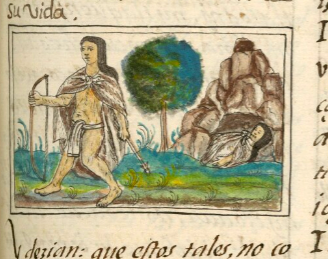oztotl (FCbk10f121r)
This iconographic example, featuring a cave (oztotl), is included in this digital collection for the purpose of making comparisons with related hieroglyphs. The term selected for this example comes from the text near the image in the Digital Florentine Codex. There is no gloss, per se. This example shows a mountain or hill (tepetl) with a cave (oztotl), and a man is lying horizontal in the cave, visible at the mouth of the cave. The man has long hair and seems to wear a cape made from an animal hide. It is tied at his neck. The cape is painted with some shading, a European artistic influence. The surrounding landscape also shows European artistic traditions have been adopted by Nahua artists.The mountain has a lot of three-dimensionality, but the emphasis is still on curvy stones (tetl), and the overall shape is still rather bell-like. The nearby text explains that the tlaminque (“shooters” who use bows and arrows) will sometimes sleep in a cave when they are on the go. The Nahuas remember cave-dwelling as a part of their origins, such as the famous migration stop at Chicomoztoc (“Seven Caves”).
Stephanie Wood
This cave shows notable European artistic influence when compared to the Chicomoztoc glyphs and other caves that have entrances akin to the mouth of an animal or an “earth monster.”
Stephanie Wood
oztotl
Stephanie Wood
1577
Jeff Haskett-Wood
cave, caves, cuevas, dormir, Chichimecas, tiradores, tlamin, tlaminque, tamime, tamimeh
ozto(tl), cave, https://nahuatl.wired-humanities.org/content/oztotl
la cueva
Stephanie Wood
Available at Digital Florentine Codex/Códice Florentino Digital, edited by Kim N. Richter and Alicia Maria Houtrouw, "Book 10: The People", fol. 121r, Getty Research Institute, 2023. https://florentinecodex.getty.edu/en/book/10/folio/121r/images/0 Accessed 30 September 2025.
Images of the digitized Florentine Codex are made available under the following Creative Commons license: CC BY-NC-ND (Attribution-NonCommercial-NoDerivs 4.0 International). For print-publication quality photos, please contact the Biblioteca Medicea Laurenziana ([email protected]). The Library of Congress has also published this manuscript, using the images of the World Digital Library copy. “The Library of Congress is unaware of any copyright or other restrictions in the World Digital Library Collection. Absent any such restrictions, these materials are free to use and reuse.”




